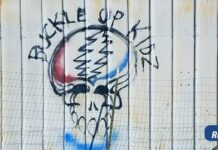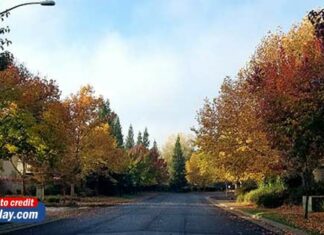Rocklin, Calif.- In 1895 horse doctor Mansfield Delano and his wealthy brother Ira, owner of Rocklin”s most successful granite quarry, led a group of nine investors to form the Rocklin Driving Park Association and build Rocklin”s first and only race track. (Note 1.)
Early Rocklin maps don’t show the track, but some of Rocklin”s old timers remember that it was located immediately northeast of today’s Rocklin Grade School on Meyers Street. Rocklin historian Uno Hebuck said that it was a one half mile oval. Penryn historian Cliff Kennedy has shown from an early 20th century photo that the grandstands probably faced toward the northeast. The street now on the northern border of grade school grounds led to the track’s vehicle entrance. That street is still named Racetrack Road.
Rocklin”s track was home to the Rocklin Driving Club which held buggy races, horse races and bike races there, mainly on weekends and holidays. Placer Herald reports of late 1890’s horse race results show that a typical purse was $30 with $18 for the winner, $9.00 for second and $3.00 for third.
At a Fourth of July celebration in 1898 cash prizes went to the winner of a ‘free-for-all’ horse race and winners of both men’s and ladies bike races. Cash also went to winners of several foot races that day.
A lady bike race winner typically would receive $3.00, with $1.50 for second and fifty cents for third. Prizes for male bike racers were double those amounts.
In May 1898, members of Rocklin”s baseball team constructed a ball field directly in front of the grandstand. In June, in their first game on the new field, they beat Lincoln’s team 14-11. Hebuck documents several ball games at the track from 1898 through 1911 including two games that Rocklin’s team won during the 1907 Placer County Fair which was held on track facilities. Hebuck says that the ball field closed after the 1911 season.
Some horse races limited entries to breeders from the Placer Citrus Colony. Joel Parker Whitney organized the Colony in the late 1880’s, and he and his son J. Parker Whitney were avid horse breeders and posted Whitney family horses for races. Joel Parker”s cousin John T. Whitney was one of the track’s original investors.
In March 1914, sixteen-year-old Johnny Mory’s, son of Mory’s’ saloon owner and former Rocklin City Councilman John Mory’s, won a race on a Whitney family horse named ‘Joy’. Young Johnny went on to ride in the Kentucky Derby from 1917 through 1919 but finished out of the money all three years.
Hebuck says that the last horse race at Rocklin’s track occurred in 1914 (note 2), but activity at the track had probably slowed several years earlier. Rocklin”s economy was in decline after Rocklin”s railroad roundhouse operations moved to Roseville in 1908. Also, Rocklin”s granite industry felt increasing competition from cement-based concrete throughout the early 20th century.
The end of state-sanctioned betting operations came in 1909 when California outlawed horse race wagering, however one photograph in the Rocklin History Museum archives shows a packed grandstand as late as 1914. Perhaps the crowd was watching horse racing and buggy racing while friends bet secretly with each other. One document from the period indicates that Rocklin’s postmaster booked race bets.
The final blow to track owners’ hopes for financial success probably came in 1915 when granite quarrymen struck the quarry owners for a raise from $3.25 to $3.75 per day. Most of Rocklin’s quarries closed that year and never reopened. (Note 3)
Rocklin historian Ruben Ruhkala remembers that track facilities burned down before 1920 and were never rebuilt. State records show that the Rocklin Driving Club disbanded in 1922 after several years of inactivity.
Today, in 2006, urban development covers Rocklin Race Track grounds. The county road that bordered the track’s western edge has disappeared from the landscape, although the barn for one of the houses on Grove Street is still aligned to front that road.
Notes
(1) According to Rocklin, by Leonard Davis, p.115, race track property was once part of Dana Perkins’s 200 acre ranch. Perkins was a 1850s Rocklin pioneer. According to Rocklin’s City website, Perkins donated property for the track in 1893. A Placer Herald Article of April 8, 1893 indicates that construction of the track would be completed by May 1 of that year. Curiously, the Rocklin Driving Park Association filed their papers of incorporation, including a detailed statement of intention to build the track, in 1895, two years later. A search of Placer Herald files indicates that significant activity at the track probably didn’t start before 1897. One possible reason for the conflicting information about the track’s opening date is the severe depression that hit the country in 1893. That depression started the decline of the Placer Citrus Colony and might have adversely affected Rocklin’s granite and railroad operations also. Track construction might have stopped in 1893 waiting for a recovering economy and new investors.
(2) Hebuck, My Memories of Rocklin, Racetrack Section. Hebuck says that May 3, 1914 was the last day of horse racing, however Placer Herald articles of June 27. 1914 and July 11, 1914 indicate that at least two large horse race meets occurred after that date. The last horse race might have been held on July 4, 1914.
(3) Stonecutters struck at the same time for a raise from $5.00 to $5.60 per day
(21+ years strong)
Welcome to the brighter side!
Get in front of local customers! 24/7 (365)





















